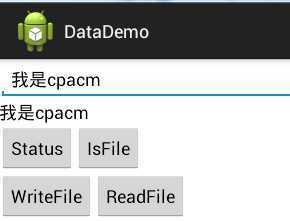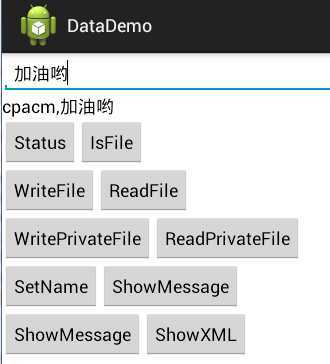标签:android style blog http io ar color os 使用
数据和程序是应用构成的两个核心要素,数据存储永远是应用开发中最重要的主题之一,也是开发平台必须提供的基础功能。不光是在Android平台上,在其他的平台上,数据的存储永远是不可缺少的一块。Android的数据存储是构建在Linux的文件系统上,它充分利用Linux的账号系统来限定应用对数据的访问,部署了一套安全和灵活并重的数据存储解决方案。Android的文件框架,以及各种数据存储手段,具体包括:Android的文件系统操作,设置文件的使用,数据库的使用,数据源组件的使用以及云端数据的存储。
| 目录 | 内容 |
| system | 系统目录,放置在Android运行所需的核心库 |
| data | 应用目录,放置着运行在Android上的应用及其数据 |
| sdcar | 扩展存储卡目录,用来存放共享的数据 |
| mnt | 记录Android挂载的外部存储信息 |
2.Android的应用数据存储机制
在Android中,第三方应用及其数据,都存放在data目录下。其中,应用安装包会被存放到/data/app/目录下,每个安装包的文件名都形如:应用包名.apk,以避免重复。 比如包名为com.test.sample的应用,其应用数据的目录为/data/data/com.test.sample/。对应的数据库文件存储在/data/data/com.test.sample/database/目录下,设置文件存储在/data/data/com.test.sample/shared_prefs/,自定义的应用数据文件存储在目录/data/data/com.test.sample/files/下,等等。 不仅如此,Android还会为每个应用创建一个账号,只有通过本应用的账号才有权限去运行该应用的安装包文件,读写应用数据目录下的文件(当然root权限除外啊~),从而保证了该应用数据不会再被其他应用获取或破坏。
3. Android的文件操作
从应用数据目录下可以看出,数据文件可以分成两类,一类是放置在扩展存储器中的文件,即/sdcard/目录下的文件,它们可以被各个应用共享;而另一类则是放在该应用数据目录下文件,它们仅能被各个应用独享,不能被其他应用读写。 (1)扩展存储器中的文件读写方式跟标准的java文件处理无异。 我们可以新建一个FileUtil的工具类来帮助我们处理文件的I/O操作,首先我们先判断SD卡的状态,看看SD卡是否可用,还有多少可用容量等。新建一个FileUtil的Class,加入方法
1 // =================get SDCard information===================
2 public static boolean isSdcardAvailable() {
3 String status = Environment.getExternalStorageState();
4 //Environment.MEDIA_MOUNTED表示SD卡正常挂载
5 if (status.equals(Environment.MEDIA_MOUNTED)) {
6 return true;
7 }
8 return false;
9 }
10
11 public static long getSDAllSizeKB() {
12 //sd卡的位置
13 File path = Environment.getExternalStorageDirectory();
14 //StatFs获取的都是以block为单位的
15 StatFs sf = new StatFs(path.getPath());
16 // 得到单个block的大小
17 long blockSize = sf.getBlockSize();
18 // 获取所有数据块数
19 long allBlocks = sf.getBlockCount();
20 // 返回SD卡大小
21 return (allBlocks * blockSize) / 1024; // KB
22 }
23
24 /**
25 * free size for normal application
26 * @return
27 */
28 public static long getSDAvalibleSizeKB() {
29 File path = Environment.getExternalStorageDirectory();
30 StatFs sf = new StatFs(path.getPath());
31 long blockSize = sf.getBlockSize();
32 long avaliableSize = sf.getAvailableBlocks();
33 return (avaliableSize * blockSize) / 1024;// KB
34 }
Environment.getExternalStorageDirectory()表示获取扩展存储器的目录。(建议使用此方法动态获取,因为sdcard这个目录路径是可配置的) StatFs.getBlockSize在API18后变为StatFs.getBlockSizeLong,其他类似的getBlock方法也一样,关于StatFs,详情可以看这篇博文 然后在activity中的button1加入事件
case R.id.button1: {
Log.d("TEST", "sdcard?"+FileUtil.isSdcardAvailable());
Log.d("TEST", "全部容量"+(float)FileUtil.getSDAllSizeKB()/1024/1024);
Log.d("TEST", "可用容量"+(float)FileUtil.getSDAvalibleSizeKB()/1024/1024);
Toast.makeText(this, "status", Toast.LENGTH_SHORT).show();
break;
}
运行结果如下 
接下来我们来判断某个文件夹是否存在在SD卡中以及创建一个文件夹
/**
* @param director 文件夹名称
* @return
*/
public static boolean isFileExist(String director) {
File file = new File(Environment.getExternalStorageDirectory()
+ File.separator + director);
return file.exists();
}
/**
* create multiple director
* @param path
* @return
*/
public static boolean createFile(String director) {
if (isFileExist(director)) {
return true;
} else {
File file = new File(Environment.getExternalStorageDirectory()
+ File.separator + director);
if (!file.mkdirs()) {
return false;
}
return true;
}
}
其中File.separator是表示分隔符,在不同操作系统下是不同的,如windows就是代表"/",而在Linux下却是代表"\"。所以介意使用File.separator来代替分隔符。File.mkdirs()表示创建一个文件夹,且可附带创建父目录,而mkdir()不行,详情的File大家可以查看官方文档,或者看看这篇博文 然后在activity中的button2加入响应事件
case R.id.button2: {
Log.d("TEST", "example文件夹存在?"+FileUtil.isFileExist("example"));
Log.d("TEST", "创建forexample文件夹"+FileUtil.createFile("forexample"));
Toast.makeText(this, "IsFile", Toast.LENGTH_SHORT).show();
break;
}
运行后可以看到  我们会发现在手机的sdcard目录下新建了一个forexample的文件夹。 最后我们来实现文件的读和写 写:
我们会发现在手机的sdcard目录下新建了一个forexample的文件夹。 最后我们来实现文件的读和写 写:
/**
*
* @param director
* (you don‘t need to begin with
* Environment.getExternalStorageDirectory()+File.separator)
* @param fileName
* @param content
* @param encoding
* (UTF-8...)
* @param isAppend
* : Context.MODE_APPEND
* @return
*/
public static File writeToSDCardFile(String directory, String fileName,
String content, String encoding, boolean isAppend) {
// mobile SD card path +path
File file = null;
OutputStream os = null;
try {
if (!createFile(directory)) {
return file;
}
file = new File(Environment.getExternalStorageDirectory()
+ File.separator + directory + File.separator + fileName);
os = new FileOutputStream(file, isAppend);
if (encoding.equals("")) {
os.write(content.getBytes());
} else {
os.write(content.getBytes(encoding));
}
os.flush();
} catch (IOException e) {
Log.e("FileUtil", "writeToSDCardFile:" + e.getMessage());
} finally {
try {
if (os != null) {
os.close();
}
} catch (IOException e) {
e.printStackTrace();
}
}
return file;
}
/**
* write data from inputstream to SDCard
*/
public File writeToSDCardFromInput(String directory, String fileName,
InputStream input) {
File file = null;
OutputStream os = null;
try {
if (createFile(directory)) {
return file;
}
file = new File(Environment.getExternalStorageDirectory()
+ File.separator + directory + File.separator + fileName);
os = new FileOutputStream(file);
byte[] data = new byte[bufferd];
int length = -1;
while ((length = input.read(data)) != -1) {
os.write(data, 0, length);
}
// clear cache
os.flush();
} catch (Exception e) {
Log.e("FileUtil", "" + e.getMessage());
e.printStackTrace();
} finally {
try {
os.close();
} catch (Exception e) {
e.printStackTrace();
}
}
return file;
}
从上面可以看到有两种写入的方法,一种是将字符串直接写入,另一种是将数据流写到文件中。还有一点要提的是file的默认目录就是sdcard的目录,所以开头不必每次都要加sdcard的目录路径。 FileOutputStream(file, isAppend) 两个参数,左边是File文件,而右边是一个boolean值,为true时,数据将会接在原来文件的后面写入,而false是则会覆盖。 读:
public static String ReadFromSDCardFile(String directory,String fileName){
String res="";
File file = null;
file = new File(Environment.getExternalStorageDirectory()
+ File.separator + directory + File.separator + fileName);
try {
FileInputStream fis = new FileInputStream(file);
int length = fis.available();
byte [] buffer = new byte[length];
fis.read(buffer); //将字节按照编码格式转成字符串
res = EncodingUtils.getString(buffer, "UTF-8");
fis.close();
return res;
}catch (FileNotFoundException e) {
// TODO Auto-generated catch block
Log.d("TEST", "FileNotFound");
e.printStackTrace();
}catch (Exception e) {
Log.d("TEST", "Can Not Open File");
e.printStackTrace();
}
return null;
}
编码默认是UTF-8,若是想要改变的话,将其作为参数传入就行。 Activity中在按钮中加入响应
case R.id.button3: {
FileUtil.writeToSDCardFile("forexample", "test.txt",
editText.getText().toString(), "UTF-8", true);
Toast.makeText(this, "WriteFile", Toast.LENGTH_SHORT).show();
break;
}
case R.id.button4: {
textView.setText(FileUtil.ReadFromSDCardFile("forexample", "test.txt"));
Toast.makeText(this, "ReadFile", Toast.LENGTH_SHORT).show();
break;
}
在文字编辑框上写入“我是cpacm”,先点击writefile按钮,再点击ReadFile,得到运行结果

同时在根目录下的forexample文件夹里会找到test.txt,里面有着“我是cpacm”的一行字。到此,文件的读写成功。 (2)放在该应用数据目录下的文件读写 存储在应用目录下的私有数据目录,通常不会通过File类的方式直接读写,而是利用一些封装过的类或函数来操作。一般可以通过Context.openFileOutput来执行。 在Activity加入两个方法,分别为文件的读和写
public void writeFile(String fileName,String writestr){
try{
FileOutputStream fout =openFileOutput(fileName,MODE_PRIVATE);
byte [] bytes = writestr.getBytes();
fout.write(bytes);
fout.close();
}
catch(Exception e){
e.printStackTrace();
}
}
//读数据
public String readFile(String fileName){
String res="";
try{
FileInputStream fin = openFileInput(fileName);
int length = fin.available();
byte [] buffer = new byte[length];
fin.read(buffer);
res = EncodingUtils.getString(buffer, "UTF-8");
fin.close();
}
catch(Exception e){
e.printStackTrace();
}
return res;
}
同时在按钮的响应中加入
case R.id.button5: {
writeFile("test2.txt",editText.getText().toString());
Toast.makeText(this, "WritePrivateFile", Toast.LENGTH_SHORT).show();
break;
}
case R.id.button6: {
textView.setText(readFile("test2.txt"));
Toast.makeText(this, "ReadPrivateFile", Toast.LENGTH_SHORT).show();
break;
}
效果图跟上张一样。
最后不要忘记在配置文件中声明权限
<uses-permission android:name="android.permission.WRITE_EXTERNAL_STORAGE" />
<uses-permission android:name="android.permission.MOUNT_UNMOUNT_FILESYSTEMS" />
用户在使用应用时,常常会有一些个人偏好。为了满足不同用户的需求,应用通常会提供对应的设置项(Preference),让用户根据自己的喜好选择。这些设置信息会存储在本地并进行结构化地展示,使用户可以编辑。
private SharedPreferences userInfo;
//在界面组件或服务组件中调用,构造应用默认的设置文件,默认文件名字为_preferences.xml
//userInfo = PreferenceManager.getDefaultSharedPreferences(this);
//或获取指定名字的SharedPreferences对象 参数分别为存储的文件名和存储模式。
userInfo = getSharedPreferences("preferences", Activity.MODE_PRIVATE);
//读取数据,如果无法找到则会使用默认值
String username = userInfo.getString("name", "未定义姓名");
String msg = userInfo.getString("msg", "未定义信息");
//显示文本
textView.setText(username+","+msg);
两种获取方式,默认或者指定一个文件 接下来加入响应按钮
case R.id.button7: {
//获得SharedPreferences的编辑器
SharedPreferences.Editor editor = userInfo.edit();
//将信息存入相应的键值中
editor.putString("name", editText.getText().toString()).commit();
Toast.makeText(this, "SetName", Toast.LENGTH_SHORT).show();
break;
}
case R.id.button8: {
//获得SharedPreferences的编辑器
SharedPreferences.Editor editor = userInfo.edit();
//将信息存入相应的键值中ss
editor.putString("msg", editText.getText().toString()).commit();
Toast.makeText(this, "SetMessage", Toast.LENGTH_SHORT).show();
break;
}
case R.id.button9: { //获得SharedPreferences文件
userInfo = getSharedPreferences("preferences", Activity.MODE_PRIVATE);
String username = userInfo.getString("name", "未定义姓名");
String msg = userInfo.getString("msg", "未定义信息");
textView.setText(username+","+msg);
Toast.makeText(this, "ShowMsg", Toast.LENGTH_SHORT).show();
break;
}
case R.id.button10: { //输出XML文件
textView.setText(print());
Toast.makeText(this, "ShowXML", Toast.LENGTH_SHORT).show();
break;
}
按钮7,8可以设置信息,按钮9则从SharedPreferences文件中读取信息并显示在文字框中。按钮10会显示这个XML文件中的所有信息。 
访问其他应用中的Preference(在SecondApp中访问FirstApp的数据),前提条件是:FirstApp的preference创建时指定了Context.MODE_WORLD_READABLE或者Context.MODE_WORLD_WRITEABLE权限。
如:在<package name>为com.first.app的应用使用下面语句创建了preference("first_app_perferences")。
在SecondApp中要访问FirstApp应用中的preference,首先需要创建FirstApp应用的Context,然后通过Context 访问preference ,访问preference时会在应用所在包下的shared_prefs目录找到preference
Context firstAppContext = createPackageContext("com.first.app", Context.CONTEXT_IGNORE_SECURITY);
SharedPreferences sharedPreferences = firstAppContext.getSharedPreferences("first_app_perferences", Context.MODE_WORLD_READABLE);
String name = sharedPreferences.getString("name", "");
int age = sharedPreferences.getInt("age", 0);
如果不通过创建Context访问FirstApp应用的preference,可以以读取xml文件方式直接访问FirstApp应用的preference对应的xml文件,
如: File xmlFile = new File(“/data/data/<package name>/shared_prefs/first_app_perferences.xml”);//<package name>应替换成应用的包名: com.first.app
public class PreferencesDemo extends PreferenceActivity{
@Override
public void onCreate(Bundle savadInstanceState){
super.onCreate(savadInstanceState);
this.addPreferencesFromResource(R.xml.preference);
}
}
其中,R.xml.preference表示描述设置信息的资源文件。放在XML资源目录下。 详细可以参考Android的配置界面PreferenceActivity

1 public class MainActivity extends Activity implements OnClickListener {
2
3 /** 存储后的文件路径:/data/data/<package name>/shares_prefs + 文件名.xml */
4 public static final String PATH = "/data/data/com.example.datademo/shared_prefs/preferences.xml";
5 private SharedPreferences userInfo;
6
7 private Button button1;
8 private Button button2;
9 private Button button3;
10 private Button button4;
11 private Button button5;
12 private Button button6;
13 private Button button7;
14 private Button button8;
15 private Button button9;
16 private Button button10;
17 private TextView textView;
18 private EditText editText;
19
20 @Override
21 protected void onCreate(Bundle savedInstanceState) {
22 super.onCreate(savedInstanceState);
23 setContentView(R.layout.activity_main);
24
25 // 获得界面的控件
26 textView = (TextView) findViewById(R.id.textView1);
27 editText = (EditText) findViewById(R.id.editText1);
28 button1 = (Button) findViewById(R.id.button1);
29 button1.setOnClickListener(this);
30 button2 = (Button) findViewById(R.id.button2);
31 button2.setOnClickListener(this);
32 button3 = (Button) findViewById(R.id.button3);
33 button3.setOnClickListener(this);
34 button4 = (Button) findViewById(R.id.button4);
35 button4.setOnClickListener(this);
36 button5 = (Button) findViewById(R.id.button5);
37 button5.setOnClickListener(this);
38 button6 = (Button) findViewById(R.id.button6);
39 button6.setOnClickListener(this);
40 button7 = (Button) findViewById(R.id.button7);
41 button7.setOnClickListener(this);
42 button8 = (Button) findViewById(R.id.button8);
43 button8.setOnClickListener(this);
44 button9 = (Button) findViewById(R.id.button9);
45 button9.setOnClickListener(this);
46 button10 = (Button) findViewById(R.id.button10);
47 button10.setOnClickListener(this);
48
49 //在界面组件或服务组件中调用,构造应用默认的设置文件,默认文件名字为_preferences.xml
50 //userInfo = PreferenceManager.getDefaultSharedPreferences(this);
51 //或获取指定名字的SharedPreferences对象 参数分别为存储的文件名和存储模式。
52 userInfo = getSharedPreferences("preferences.xml", Activity.MODE_PRIVATE);
53
54 //读取数据,如果无法找到则会使用默认值
55 String username = userInfo.getString("name", "未定义姓名");
56 String msg = userInfo.getString("msg", "未定义信息");
57 //显示文本
58 textView.setText(username+","+msg);
59 }
60
61 @Override
62 public void onClick(View v) {
63 // TODO Auto-generated method stub
64 switch (v.getId()) {
65 case R.id.button1: {
66 Log.d("TEST", "sdcard?"+FileUtil.isSdcardAvailable());
67 Log.d("TEST", "全部容量"+(float)FileUtil.getSDAllSizeKB()/1024/1024);
68 Log.d("TEST", "可用容量"+(float)FileUtil.getSDAvalibleSizeKB()/1024/1024);
69 Toast.makeText(this, "status", Toast.LENGTH_SHORT).show();
70 break;
71 }
72 case R.id.button2: {
73 Log.d("TEST", "example文件夹存在?"+FileUtil.isFileExist("example"));
74 Log.d("TEST", "创建forexample文件夹"+FileUtil.createFile("forexample"));
75 Toast.makeText(this, "IsFile", Toast.LENGTH_SHORT).show();
76 break;
77 }
78 case R.id.button3: {
79 FileUtil.writeToSDCardFile("forexample", "test.txt",
80 editText.getText().toString(), "UTF-8", true);
81 Toast.makeText(this, "WriteFile", Toast.LENGTH_SHORT).show();
82 break;
83 }
84 case R.id.button4: {
85 textView.setText(FileUtil.ReadFromSDCardFile("forexample", "test.txt"));
86 Toast.makeText(this, "ReadFile", Toast.LENGTH_SHORT).show();
87 break;
88 }
89 case R.id.button5: {
90 writeFile("test2.txt",editText.getText().toString());
91 Toast.makeText(this, "WritePrivateFile", Toast.LENGTH_SHORT).show();
92 break;
93 }
94 case R.id.button6: {
95 textView.setText(readFile("test2.txt"